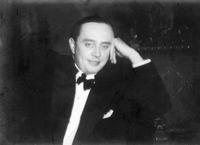Zdenek Rykr and the Chocolate Factory
Note on the circumstances of publication
125 years ago, on October 26, Zdenek Rykr was born, a painter of many styles, "a philosopher and advertising executive who was one of those jack-of-all-trades who could do anything he set his mind to." With few exceptions, he wrote the introductions to his exhibitions himself, "and so well that no intermediary could have served him better." The exhibitions were said to be even more interesting. Rykr was constantly searching for the form and style of his artistic expression, and his experiments were ahead of their time. For example, "from paper, wood, cloth, and many other ingredients, he created (...) a colorful extravaganza that has its own rhythm in terms of both content and form and captures the impression and enchantment we experience in Loreto or Karlov. His work spreads an atmosphere similar to that of the Voskovec and Werich revue, where you enjoy not only what is presented, but also the thought of how little boredom the authors must have felt when composing it." (The quotations used are from the February 1936 issue of Eva, a magazine for educated women).
Unfortunately, during the Nazi occupation on January 15, Zdenek Rykr voluntarily left this world at the age of 39. He became known to the wider public thanks to art historians Jindřich Chalupecký and Vojtěch Lahoda. This year, Vojtěch Lahoda would have turned 70. We are honored and delighted that in this double anniversary year we can revive the Zdenek Rykr retrospective, supplemented with commentary and texts by the aforementioned art historians and works that did not fit into the original exhibition at the National Gallery. The exhibition Zdenek Rykr and the Chocolate Factory took place in 2016, but its publication on artforgood.cz was complicated by personnel changes at the National Gallery and the acquisition of all the necessary consents from the owners of the works of art and reproductions. First and foremost, we would like to thank the following for their helpful cooperation: Vojtěch Lahoda in memoriam, Eva Lahodová, the then manager of the NG Marcela Straková, the then curator of the NG Lenka Pastyříková, the then director of the Chotěboř Museum Adam Rosa, and graphic designers Luboš Drtina, Tomáš Machek and Luděk Kubík.
Reproductions for the new life of the Chocolate Factory exhibition were kindly provided by: the National Gallery in Prague, the Chotěboř Municipal Museum, Museum of Decorative Arts in Prague, Prague City Gallery, Gallery of the Central Bohemian Region, Kutná Hora, Gallery of Modern Art in Roudnice nad Labem, Regional Gallery in Liberec, Gallery of Modern Art in Hradec Králové, Olomouc Museum of Art, Benedikt Rejt Gallery in Louny.
(In Prague, October 26, 2025 Pavlína Bartoňová)
National Gallery in Prague, Trade Fair Palace
27. May 2016 - 28. August 2016
Concept originator Vojtěch Lahoda and curator Lenka Pastyříková
The work of Zdenek Rykr (1900–1940) is attractive due to its intentional resignation of a single style mode. This painter, still somewhat neglected, produced expressionist, realist and cubist works, but also worked in the spirit of neo-classicism, sensual realism, neo-fauvism, abstraction and surrealism and created collages and assemblages, as well as sculptures and objets d’art. He was simultaneously conservative and avant-garde. Rykr is also attractive in his oscillation between modern art and advertising activity. In 1921 he began designing packaging and publicity flyers and posters for the firm of Maršner-Orion, later just Orion, one of the largest manufacturers of chocolate and confectionary in Czechoslovakia between the wars. The sophistication and originality of the packaging of Orion chocolate was unrivalled at its time, as was the long-term activity of the artist for the firm of Orion right up to 1939. Rykr’s “invention” of the Orion chocolate star, the cord lettering of the name Orion and the motif of the blackamoor on the packaging of the famous Kofila chocolate bar all testify to the unbelievable abilities of this young self-taught artist. Čedok, Káva Kulík, the Horch car plant of Germany, Dr. Zátka, Škoda and Baťa were other companies in the promotion of which Zdenek Rykr participated.
Rykr was a skilful draughtsman and caricaturist, who contributed to the satirical periodical Trn (Thorn), wrote feuilletons, which he frequently also illustrated, and edited the periodical Domov a svět (Home and the World). He was unusually successful both in advertising and in free creativity, but also as an art critic and journalist. As early as in 1921 he was exhibiting as a self-taught artist and student with the famous Tvrdošíjní group of artists and in the thirties he exhibited in Paris in the Salon des Surindependents. He also played a significant part in the exhibition of the Spa Industry in the Czechoslovak Pavilion of architect Jaromír Krejcar at the World Exhibition in Paris in 1937. Likewise linked with the interesting and widespread work of Zdenek Rykr, however, is the powerful personal story of a commercially successful artist who was, in spite of this, an outsider on the art scene. Under the pressure of the occupation of Czechoslovakia by Nazi German Rykr committed suicide in 1940. The exhibition in the Trade Fair Palace presents Rykr’s work in its full breadth and entirety. The blurring of the boundaries between high and low and between individual stylistic tendencies shows that the work of Zdenek Rykr continues to be topical.
Author: Vojtěch Lahoda
Curator: Lenka Pastýříková
In cooperation with: Regional Museum in Kolin and organization CEKUS Chotěboř, City Museum
Main partners of the exhibition: Orion, Nestlé
Supported by: Ministerstvo kultury ČR
General partner of the National Gallery: Komerční banka
Partner of the exhibition: National Film Archive, The Institute of Art History of the Academy of Sciences of the Czech Republic
General media partner: Česká televize
Main shipper: Czech Railways
Media partners of the exhibition: Týdeník ECHO, EXPRES FM
Media partners: Český rozhlas, Art & Antiques, Flash Art, ArtMap, PRAGUEEVENTSCALENDAR, ART+, The Museum Channel, Art for Good New Life for Exhibitions.



